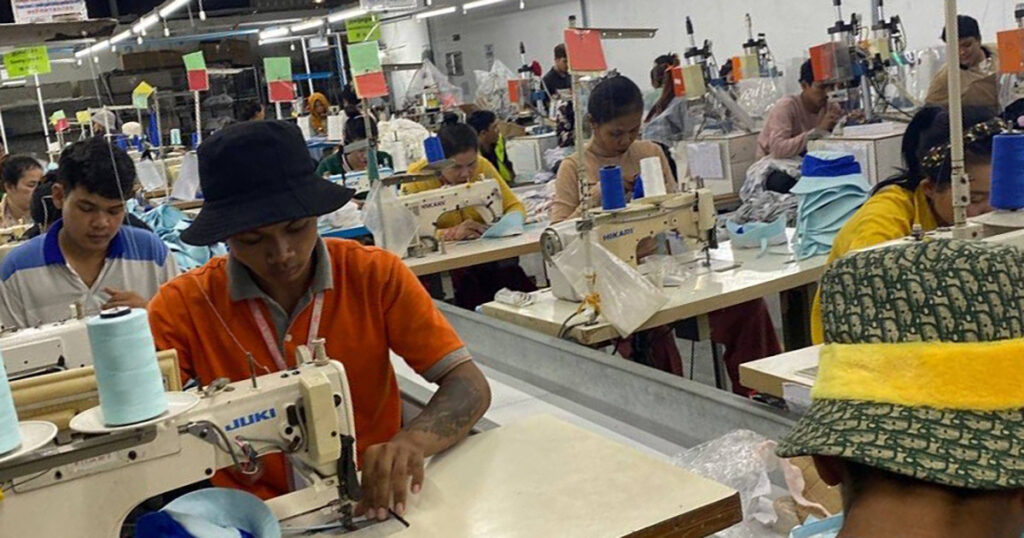This article was produced by ProPublica in partnership with The Oregonian/OregonLive. Sign up for Dispatches, to get stories like this one as soon as they are published.
In Phnom Penh’s hot season, when the Cambodian capital’s sweltering, subtropical air routinely soars to 100 degrees, more workers than usual visited the infirmaries inside a factory that made baby clothes for Nike, the world’s largest athletic apparel brand.
As many as 15 people a month typically became too weak to work in May and June, according to a medical worker employed by the factory. Even at other times of year, she said, eight to 10 workers wound up in the clinic monthly because they felt weak, including one or two a month who fell unconscious and needed to go to the hospital.
Other former employees told ProPublica they sometimes saw two or three people a day taken to an on-site clinic. One described how he carried workers too weak to walk. Another said she saw thin workers being taken to the clinic, their faces pale and eyes closed.
Y&W Garment’s employees — at one time numbering around 4,500 — operated sewing machines and packaged clothing in cavernous buildings with fans but no air conditioning. The fans sometimes broke and weren’t fixed, one worker said. Another said the inside of the factory could get hotter than it was outdoors. “It’s so hot,” said Phan Oem, 53, who started working there shortly after the factory opened in 2012. “I’m sweaty. It’s too hot.”
Credit:
Sarahbeth Maney/ProPublica
Workers have fainted for years inside Cambodia’s garment factories, where more than 57,000 people now produce Nike goods. People at Nike’s suppliers fainted en masse in 2012, 2014, 2017, 2018 and 2019, according to news reports at the time, part of a string of events in which thousands of Cambodians got sick, vomited or collapsed on the job. (The term “fainting” in Cambodia is used for conditions that range from losing consciousness to becoming too dizzy or weak to work.)
Nike had moved into Cambodia in 2000, just two years after co-founder Phil Knight promised to end labor abuses that accompanied its push into Southeast Asia.
Nike took action after faintings made headlines. It sent executives on a fact-finding mission in 2012. It asked for international labor officials to investigate. Nike in 2017 told The Guardian, “We take the issue of fainting seriously, as it can be both a social response and an indication of issues within a factory that may require corrective action.”
Yet for all the measures Nike says it relies on to keep workers safe, which include heat standards in factories, internal and external audits, announced and unannounced visits, Y&W workers said fainting persisted during the two years Nike products were made there.
Jill Tucker, who led the U.N.-backed oversight group Better Factories Cambodia from 2011 to 2014, said she was not surprised to hear that workers regularly fainted at Y&W Garment.
The problem is “a consequence of low wages and poor working conditions that continue, even after decades of work on this issue,” Tucker said. “People work very hard for very little pay.”
Representatives of Y&W Garment and its parent company, Hong Kong-based Wing Luen Knitting Factory Ltd., did not respond to emails, text messages or calls.
It’s unclear what Nike knew about working conditions at the Phnom Penh factory. Better Factories Cambodia, whose audits Nike has said in the past it relied on to monitor suppliers, told ProPublica it did not know workers were fainting at Y&W. ProPublica previously reported on low wages at Y&W, where just 1% of workers made what Nike says is typical of workers in its supply chain.
Nike didn’t answer ProPublica’s questions, including about whether it stopped working with the Y&W factory because of any violations of its code of conduct. Y&W Garment stopped making Nike apparel in late 2023, shortly before going bankrupt, workers told ProPublica. Nike said in a statement that it is “committed to ethical and responsible manufacturing” and sets clear expectations for its suppliers through its code of conduct.
Workers said Nike garments at Y&W were produced under the auspices of Haddad Brands, a private New York company whose website says it produces Nike children’s clothing and enforces Nike’s code of conduct. Haddad did not respond to repeated emails; someone who answered its phone hung up on a reporter who called, and no one responded to a subsequent voicemail.
On its website, Haddad says it works directly with its factories “to ensure that each of our suppliers has the ability to not only manufacture our product, but to do so responsibly — for the workers, for the environment, and for our customers.”
At Y&W Garment, a set of corrugated metal buildings along both sides of a busy road in rapidly developed southern Phnom Penh, two workers said faintings were so frequent that they were no longer surprising. The medical employee interviewed by ProPublica blamed overtime hours and workers not sleeping much or eating enough.
If employees fell unconscious, they went to the hospital, the medical worker said. Otherwise, they were given calcium pills and allowed to rest on a thin mat spread on a metal cot.
Then, she said, they typically went back to work.
Y&W is not an isolated case. The Cambodian government reported more than 4,500 faintings in factories between 2017 and 2019, according to news reports, a problem it has attributed to pesticide spraying, chemicals used in manufacturing, heat, poor nutrition and inadequate ventilation. Media reports also quoted the government citing psychological factors, such as workers’ beliefs in supernatural forces.
Bill Clinton set out to alleviate harsh working conditions in Cambodia’s factories in 1999, when as president he signed a trade deal that greatly expanded Cambodian garment exports to the United States.
Cambodia’s emerging industry at the time was helping to shore up the country’s economy as it recovered from war and the 1970s Khmer Rouge genocide. A few months after the trade deal was signed, an incident illustrated why labor issues were a concern. More than two dozen exhausted workers fainted at a Phnom Penh garment factory. A union representative told a local newspaper they’d been working 14-hour days, fearful they’d be fired.
The Clinton trade agreement called for creating a labor monitor to bring Cambodia’s factories up to international standards. If the manufacturers improved their working conditions, the United States would expand its import quotas. Better Factories Cambodia, which is part of the United Nations’ International Labor Organization and has been funded by the U.S. Labor Department, began operating in 2001.
Credit:
AFP via Getty Images
The group would ensure “American companies like Gap or Nike feel safe placing orders in Cambodia, knowing that factories comply with human rights, labor laws and good working conditions,” Van Sou Ieng, then-president of the Cambodian garment industry’s trade association, told Vogue in 2002.
Nike, which had withdrawn from the country when a BBC investigation in 2000 found children as young as 12 working for a Nike supplier, returned after Better Factories Cambodia launched. The company has repeatedly pointed to Better Factories Cambodia as an essential part of its factory oversight over the years. In 2012, Nike said that it relied on the group’s factory audits, rather than conducting its own, to ensure adequate working conditions in the country. (Nike did not respond when asked about Better Factories Cambodia’s current role in auditing.)
Unlike workplace safety regulators in the United States, Better Factories Cambodia was not given enforcement power to fine or shut down problem factories. In addition, industry and government made up two-thirds of the organization’s advisory committee. That gave them much more influence than workers, according to Tucker.
In 2012, Better Factories Cambodia took on mass faintings with something called the One Change Campaign. It followed a string of media reports that prompted a frantic search for solutions, Tucker said. The idea was to get each factory owner to do one thing to reduce fainting that the law didn’t already require. It might be free lunches, snacks or twice-daily paid exercise programs to combat fatigue and monotony — aerobics for workers who were at risk of being malnourished.
“It was just lame,” said Tucker, who was the organization’s leader at the time. She said she came to realize that the agency was taking the wrong approach, focusing on short-term initiatives instead of tackling the root causes of problems.
Better Factories Cambodia has had a mixed record since then.
It has called attention to the failure of Cambodian factories to obey labor standards. The organization in February reported that almost half of the more than 350 factories it inspected in 2023 made employees work excessive overtime hours, while two-thirds of factories were hotter than the organization’s recommended 90 degrees Fahrenheit. The report didn’t identify the factories.
Daramongkol Keo, a Better Factories Cambodia spokesperson, said the organization has seen meaningful improvements in wage compliance, gender equality, working hours and workplace safety while it has been operating. He said the group has consistently monitored and reported fainting incidents in Cambodia.
For all the issues it’s uncovered, though, labor advocates say its inspectors miss many more.
A 2024 report from the Center for Alliance of Labor and Human Rights, a Cambodian legal aid group, found that Better Factories gave perfect marks for labor union compliance even at factories where employees said union busting was pervasive.
If Better Factories’ findings don’t reflect actual working conditions, the report said, “then everyone is participating — whether willingly or not — in a large-scale whitewashing scheme.”
When asked for a response to the criticism, the leader of Better Factories Cambodia, Froukje Boele, told ProPublica, “we appreciate the report’s focus and emphasis on working conditions, freedom of association and collective bargaining.”
Cambodia’s garment industry praises Better Factories Cambodia’s work. Ken Loo, the current head of the industry’s trade group, said the program complements government and industry efforts “to ensure high levels of social and labor compliance.”
Better Factories Cambodia was unaware of the incidents at Y&W Garment that former workers described to ProPublica, according to Keo, the spokesperson. That’s despite conducting four inspections from March 2020 through July 2023.
The organization acknowledged some shortcomings of its two-day, unannounced audits in a report this year. It said problems like sexual harassment and efforts to interfere with union organizing are hard to verify.
“If fainting incidents were known but not adequately addressed at the factory level,” Keo told ProPublica, “it underscores the broader challenges of enforcement and accountability within the industry.”
Had the issue of faintings been confined to Cambodia, the shortcomings of Better Factories Cambodia might explain Nike’s failure to rid its supply chain of the problem. That wasn’t the case, according to findings of a labor monitoring group in Vietnam in 2016.
That year, the Worker Rights Consortium described numerous faintings at a Vietnamese supplier of Nike and other Western brands. Workers at Hansae Vietnam in Ho Chi Minh City told the group that pressure to meet production targets in the un-air-conditioned factory was so high that they didn’t drink water to save time visiting the toilet. Hundreds of workers went on strike, twice.
Credit:
Obtained and highlighted by ProPublica
The consortium called in a certified industrial hygienist, Garrett Brown, to conduct an independent investigation.
It was months before Brown was allowed to enter the 12-building factory complex that employed roughly 10,000 people. Inside, he and another colleague recorded temperatures as high as 95 degrees, he said.
“It was goddamn hot inside those plants, for sure,” Brown told ProPublica. By the end of the day, he said, he was exhausted.
“You’re sweating profusely, walking between the buildings and in the buildings as well,” he said. “And we were just doing it for eight hours — and a lot of workers were going for 10, 12, 14 hours.”
Hansae, which didn’t respond to emails from ProPublica, developed a remediation plan to fix the problems Brown and others had identified. It included installing cooling systems and shutting off the electricity in production areas to ensure that workers took lunch breaks. Nike no longer produces at the factory.
Temperatures came down far faster in 2021 when Nike was confronted with an employee complaint about dizziness and dehydration at Nike’s retail store in downtown Portland, which sits not far from the company’s suburban corporate headquarters.
Unlike in Vietnam, the complaint was about temperatures in the low 80s — “super hot,” one worker told an inspector from the Oregon Occupational Safety and Health Division — not the mid-90s that Brown measured in Ho Chi Minh City. And unlike in Vietnam, it took days, not months, for workplace safety inspectors to get inside.
According to a state report, the inspectors quickly discovered that the problem was already being addressed, at least temporarily. Nike had brought in five portable air conditioners, spending what a company official would later estimate was $40,000 to get the summer heat under control.
Keat Soriththeavy and Ouch Sony contributed reporting and translation. Kirsten Berg of ProPublica and Matthew Kish of The Oregonian/OregonLive contributed research.
]



